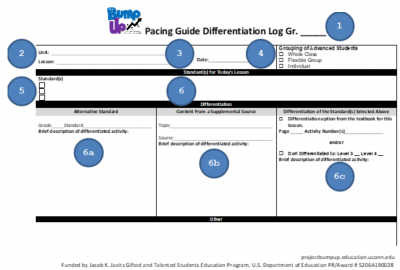The Project BUMP UP Pacing Guide Differentiation Log is a tool to guide planning and document differentiation as aligned to a pacing guide. Although it was developed with co-planning and co-teaching mathematics in mind, it may serve as a helpful organizer for selecting and recording differentiated options for individual teachers, as well, across the curriculum.
The Project BUMP UP Pacing Guide Differentiation Log includes space to document six aspects of a differentiated lesson.
- Grade Indicator: What is the grade level of this lesson?
- Unit and Lesson Indicator: What is the lesson as indicated in the pacing guide?
- Date: Will this take place over one or more days?
- Grouping Indicator: How are students being grouped?
- Standards: What are the typical standards for this lesson, and which are you differentiating?
- Differentiation: Which way are you differentiating out of the following?
- Advanced Standards: If you are differentiating up to a higher grade level that vertically extends this concept with the domain, indicate the grade, the standard, and a brief description of the differentiated activity.
- Content from a Supplemental Source: If you are selecting content from an advanced supplemental source beyond the textbook, indicate the topic, the name and page number of the source, and a brief description of the differentiated activity.
- Differentiation of the Standard(s) Selected Above: If you are increasing the challenge for a listed standard, indicate whether you are selecting an advanced option from your textbook by page and activity name or developing one at a higher Depth of Knowledge (Webb, 1997), as well as a brief description of the differentiated activity.

Link to Word copy of the Project BUMP UP Pacing Guide Differentiation Log
Webb, N. L. (1997). Criteria for alignment of expectations and assessments in mathematics and science (Council of Chief State School Officers and National Institute for Science Education Research Monograph No. 6). Madison: University of Wisconsin–Madison, Wisconsin Center for Educational Research.